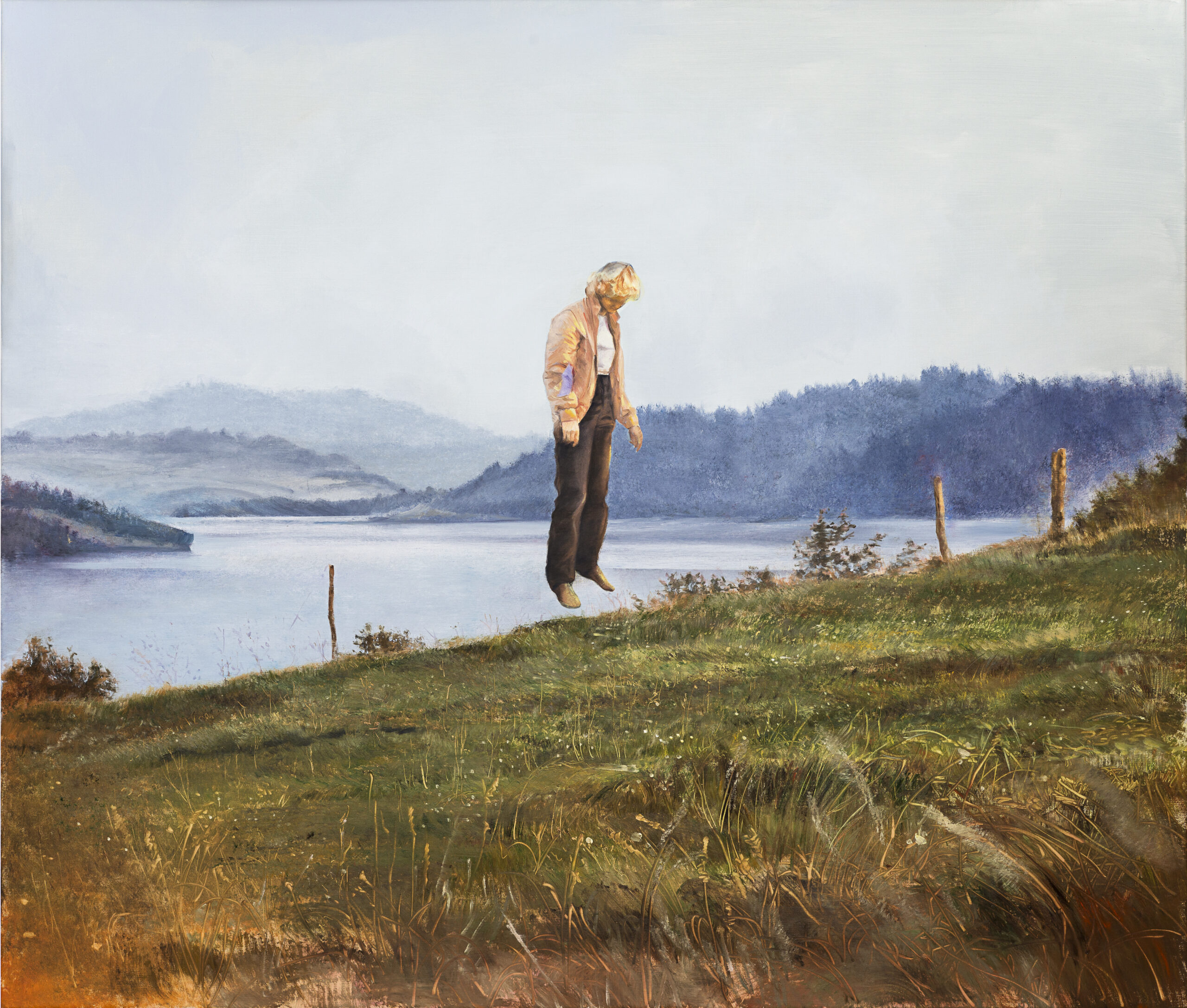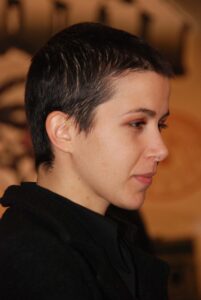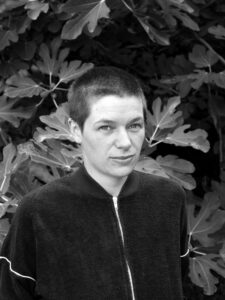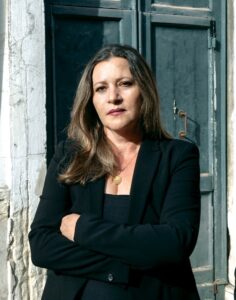Agata Kus
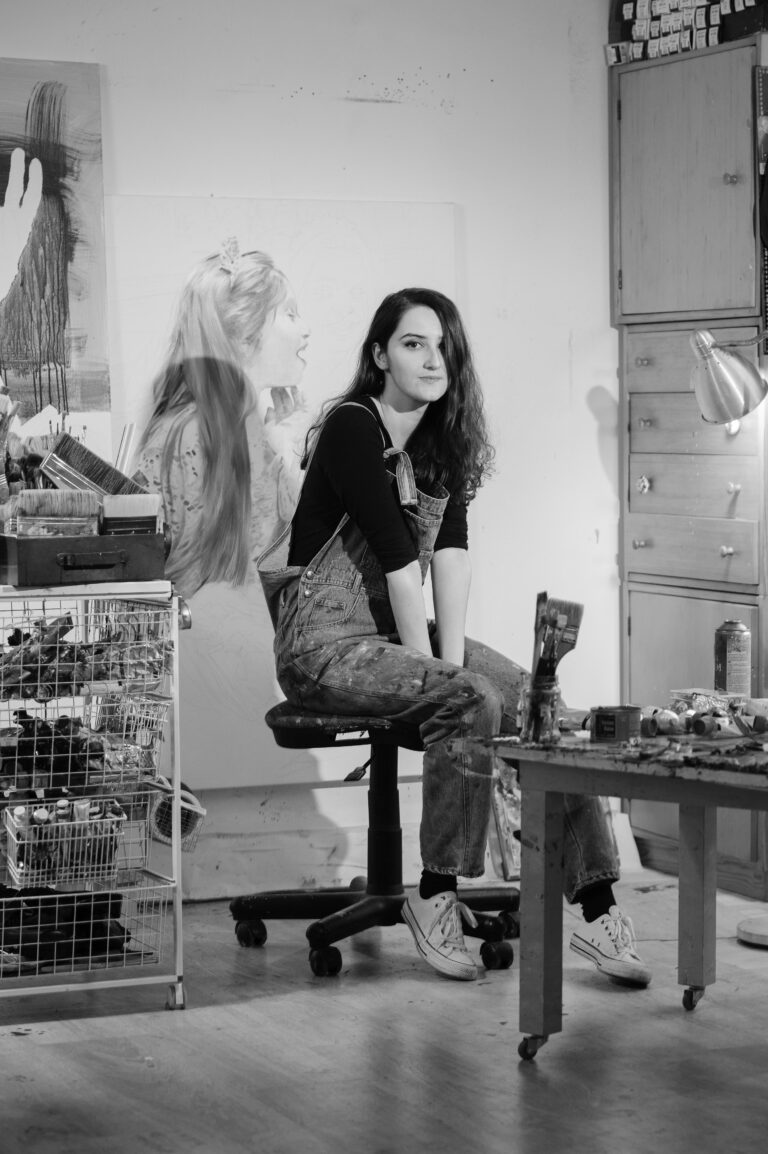
– born 1987. Lives and works in Kraków. She is a graduate and doctoral student of the local Academy of Fine Arts. She mainly works in painting, ceramics and video, and is particularly keen on realistic imagery. Her compositions are juxtapositions of fragments of reality, often accompanied by an impression of anxiety. In 2021, she won first place in the Kompas Młodej Sztuki ranking published in Rzeczpospolita.
Photo Marcin Gulis.
AN INDISPUTABLE FEELING OF UNEASE
I work in various media, but I call myself a painter with full conviction. By depicting people from my own environment or motifs and situations close to me, I often talk about difficult things, touch upon cultural and identity issues, and comment on stereotypes.
I collect photographs that intrigue me and look for connections between them, I juxtapose them until some combination reveals an unusual story to me. My large-format representations are usually painted quite loosely, expressively, I care about preserving the texture of the paint, the flow of the brush. I paint in harmony with myself, using the language of figuration, which is close to me. I rather do not follow painting fashions. The world around me seems diverse to me, full of beautiful images and amazing phenomena. I love to draw from it.
In many of my paintings I use collage-like combinations of seemingly unrelated situations. Individual areas of the canvas, like scraps of a photograph, are cut off from each other with a sharp line. In this way, I deliberately try to depart from the linearity of narration and create it not as a sum of meanings but as a combination of them into a new quality. This often reveals subtle, not always intended, content. Despite my natural tendency to use the language of realism and my weakness for classically understood beauty, I find it attractive to unmask the medium by preserving the traces of tape or pencil and its physical, material properties1. Work on small format paintings tends to take a more focused form. The paintings are fuller, more traditional and detailed, even referring to the tradition of old painting. What is important for me is the light and the structure of the forms.2
Although I am not an active feminist, there are quite a few feminist themes in my paintings. The main object of my interest and criticism is culture. I refer to situations in which culture imposes certain patterns of behaviour on us: I comment on contemporary models of masculinity34 and femininity56, violence in relationships7, or the imposition of social roles8. I am also exploring the subject of the role of the mother910 and lover11.
Some paintings are a kind of documentation of people and time, they show people from my environment. I love to draw magical contexts from the everyday. If the narrative is properly directed, a seemingly ordinary situation, such as a rock concert12 gets ever weirder after a longer observation. I often connect completely distant stories and representations13. I present people and places not only from the local environment1415; I try for the paintings to touch upon some thematic universe at the same time, to enter new contexts and dimensions.
Animals, which I like to depict, I always treat as symbols. Just as in fairy tales, they can take on the function of a guide, they are keys to discovering new contents and symbols. Contact with them is like initiation into wild, primal needs. I try to convey the strange solemnity and sacrum of a given moment, as for example in the paintings about children being tempted by foxes or goats16. I also explore the theme of transgression in my portraits of children. Sometimes it is specific film characters in moments of inner transformation (e.g. a series of portraits of carefree boys or beautiful girls whose suffering is revealed in tears made from holes burnt in the canvas by a cigarette)17.
The common denominator of all my works is undoubtedly the impression of unease. Disturbances in seemingly trivial representations of reality, illegible at first glance, build up the tension after a while and reveal hidden contents, as in the recent pandemic paintings1819, which take the form of landscapes. For me, they are a newly discovered type of imagery, but one that i have already taken a liking to.
The text was written in collaboration with Anna Kowalska (2020).
1Image: Agata Kus, First Cold, 2018, oil on canvas, 160 x 180 cm. Courtesy of the artist.2Image: Agata Kus, Mater Borelioza, 2018, oil on canvas, 40 x 30 cm. Courtesy of the artist.
3Image: Agata Kus, Maternidad, 2019, oil on canvas, 150 x 190 cm. Courtesy of the artist.
4Image: Agata Kus,Horseman, 2018, oil on canvas, 178 x 248 cm. Courtesy of the artist.
5Image: Agata Kus, Jadwiga 2017, oil on canvas, 130 x 195 cm, 2017, collection of the Museum of Contemporary Art MOCAK in Kracov. Courtesy of the artist and MOCAK Kracov.
6Image: Agata Kus, Peleas Group, 2018, oil on canvas, 200 x 140 cm, from series “Peleas and Melisande”, part of performance, Grand Theatre of the National Opera, Warsaw. Courtesy of the artist.
7Image: Agata Kus, Tainted Love, 2013, oil on canvas, 180 x 140 cm. Courtesy of the artist.
8Image: Agata Kus, Faith and Beauty, oil on canvas. Courtesy of the artist. The series of paintings inspired primarily by images of girls from the Nazi organisation Glaube und Schönheit, which prepared women to be model wives and housewives for men who were to return to their homeland after the war.
9Image: Agata Kus, Mother, 2012, video, WRO Art Center Library. Courtesy of the artist and WRO Art Center.
10Image: Agata Kus, Hair-cutting, 2020, oil on canvas, 40 x 30 cm. Courtesy of the artist.
11Image: Agata Kus, Lover, 2015, video, multi-channel installation, WRO WRO Art Center. Courtesy of the artist and WRO Art Center.
12Image: Agata Kus, Nosferatu, 2017, oil on canvas, 180 x 265 cm, Visiting Gallery. Courtesy of the artist.
13Image: Agata Kus, Pornography, 2017, oil on canvas, 180 x 160 cm. Courtesy of the artist.
14Image: Agata Kus, Idol, 2019, oil on canvas, 200 x 160 cm. Courtesy of the artist.
15Image: Agata Kus Lacrimosa, 2017, oil on canvas, 180 x 280 cm. Courtesy of the artist.
16Image: Agata Kus Wanda and the Goat of Damascus, 2020, oil on canvas, 40 x 30 cm. Courtesy of the artist.
17Image: Agata Kus, Sisters, 2016, oil on canvas, 170 x 140 cm. Courtesy of the artist.
18Image: Agata Kus, Blue Sun, 2020, oil on canvas, 190 x 160 cm. Courtesy of the artist.
19Image: Agata Kus, The Witch, 2020, oil on canvas, 160 x 190 cm. Courtesy of the artist.
– urodzona w 1987. Mieszka i pracuje w Krakowie. Jest absolwentką i doktorem tamtejszej ASP. Zajmuje się głównie malarstwem, ceramiką i wideo, szczególnie chętnie działając w obszarze realistycznego obrazowania. Jej kompozycje to zestawienia urywków rzeczywistości, którym często towarzyszy wrażenie niepokoju. W 2021 zdobyła pierwsze miejsce w rankingu Kompas Młodej Sztuki publikowanego na łamach Rzeczpospolitej.
Zdjęcie Marcin Gulis.
BEZSPRZECZNE WRAŻENIE NIEPOKOJU
Pracuję w różnych mediach, ale z całym przekonaniem nazywam siebie malarką. Obrazując ludzi z własnego środowiska lub motywy i sytuacje mi bliskie, opowiadam często o rzeczach trudnych, poruszam problemy kulturowe, tożsamościowe, komentuję stereotypy.
Kolekcjonuję intrygujące mnie fotografie i szukam związków między nimi, zestawiam do chwili, aż jakieś połączenie objawi mi niezwykłą historię. Moje wielkoformatowe przedstawienia są zazwyczaj malowane dość luźno, ekspresyjnie, zależy mi na zachowaniu faktury farby, duktu pędzla. Maluję w zgodzie ze sobą, używając bliskiego mi języka figuracji. Raczej nie ulegam malarskim modom. Świat wokół mnie wydaje mi się różnorodny, pełen pięknych obrazów i zdumiewających zjawisk. Uwielbiam z niego czerpać.
W znacznej części obrazów stosuję kolażowe połączenia pozornie niezwiązanych ze sobą sytuacji. Poszczególne obszary płótna, jak skrawki fotografii, odcinają się od siebie ostrą kreską. W ten sposób celowo staram się odchodzić od liniowości narracji i tworzyć ją nie jako sumę znaczeń, a połączenie w nową jakość. Wówczas ujawniają się często subtelne, nie zawsze zamierzone treści. Mimo naturalnej tendencji do posługiwania się językiem realizmu oraz słabości do klasycznie pojmowanego piękna, demaskowanie medium poprzez zachowywanie śladów taśmy czy ołówka i jego fizyczne, materialne właściwości wydają mi się atrakcyjne1. Praca nad małymi formatami obrazów zazwyczaj przybiera formę bardziej skupioną. Obrazy są pełniejsze, bardziej tradycyjne i szczegółowe, wręcz programowo nawiązujące do tradycji starego malarstwa. Ważne jest dla mnie światło i struktura budowy form2.
Chociaż nie jestem aktywnie działającą feministką, w moich obrazach wątków feministycznych jest sporo. Głównym obiektem mojego zainteresowania i krytyki jest kultura. Nawiązuję do sytuacji, kiedy narzuca nam ona określone schematy zachowań: komentuję współczesne modele męskości34 i kobiecości56, przemoc w związkach7, czy narzucanie ról społecznych8. Eksploruję również temat roli matki910 i kochanki11.
Niektóre obrazy są swoistą dokumentacją ludzi i czasu, pokazują osoby z mojego otoczenia. Uwielbiam wyciągać magiczne konteksty z codzienności. Przy odpowiednim poprowadzeniu narracji pozornie zwykła sytuacja, np. koncert rockowy12 po dłuższej obserwacji robi się coraz dziwniejsza. Często łączę ze sobą zupełnie odległe historie i przedstawienia.13 Przedstawiam ludzi i miejsca nie tylko ze środowiska lokalnego1415; staram się, by obrazy jednocześnie dotykały jakiegoś uniwersum tematycznego, wchodziły w nowe konteksty i wymiary.
Zwierzęta, które chętnie obrazuję, traktuję zawsze jak symbole. Podobnie jak w bajkach, mogą przyjmować funkcję przewodnika, są kluczami do odkrywania nowych treści i symbolami. Kontakt z nimi ma charakter inicjacji i wtajemniczania w dzikie, pierwotne potrzeby. Próbuję oddać dziwną powagę i sacrum danej chwili, jak np. w obrazach o kuszeniu dzieci przez lisy lub kozy16. Motyw transgresji poruszam również w portretach dzieci. Czasem to określone postaci filmowe w momentach przechodzenia wewnętrznej przemiany (np. seria portretów beztroskich chłopców lub pięknych dziewczyn, których cierpienie ujawnia się we łzach zrobionych z dziur wypalonych w płótnie papierosem)17.
Wspólnym mianownikiem wszystkich moich prac jest bezsprzecznie wrażenie niepokoju. Nieczytelne na pierwszy rzut oka zakłócenia w pozornie błahych przedstawieniach rzeczywistości, po chwili nadbudowują napięcie i ujawniają ukryte treści, jak np. w ostatnich, pandemicznych obrazach,1819 które przyjmując formę pejzażu. Są one dla mnie nowo odkrytym, ale już obdarzonym szczególną sympatią typem obrazowania.
Tekst powstał we współpracy z Anną Kowalską (2020).
1Zdjęcie: Agata Kus, First Cold, 2018, olej na płótnie, 160 x 180 cm. Dzięki uprzejmości artystki.2Zdjęcie: Agata Kus, Mater Borelioza, 2018, olej na płótnie, 40 x 30 cm. Dzięki uprzejmości artystki.
3Zdjęcie: Agata Kus, Maternidad, 2019, olej na płótnie, 150 x 190 cm. Dzięki uprzejmości artystki.
4Zdjęcie: Agata Kus, Horseman, 2018, olej na płótnie, 178 x 248 cm. Dzięki uprzejmości artystki.
5Zdjęcie: Agata Kus, Jadwiga, 2017, olej na płótnie, 130 x 195 cm, kolekcja Muzeum Sztuki Współczesnej MOCAK w Krakowie. Dzięki uprzejmości artystki.
6Zdjęcie: Agata Kus, Grupa Peleasa, 2017, 200 x 140 cm, z cyklu „Peleas i Melizanda” zrealizowanego na potrzeby spektaklu, Teatr Wielki Opera Narodowa, Warszawa. Dzięki uprzejmości artystki.
7Zdjęcie: Agata Kus, Tainted Love, 2013, olej na płótnie, 180 x 140 cm. Dzięki uprzejmości artystki.
8Zdjęcie: Agata Kus, Wiara i Piękno, cykl obrazów. Dzięki uprzejmości artystki. Cykl inspirowany jest przede wszystkim wizerunkami dziewcząt z nazistowskiej organizacji Glaube und Schönheit zajmującą się przygotowaniem kobiet do roli wzorowych żon i gospodyń domowych dla mężczyzn mających powrócić po wygranej wojnie do kraju.
9Zdjęcie: Agata Kus, Matka, 2012, wideo, kadr, biblioteka WRO Art Center. Dzięki uprzejmości artystki i WRO Art Center.
10Zdjęcie: Agata Kus, Postrzyżyny, 2020, olej na płótnie, 40 x 30 cm. Dzięki uprzejmości artystki.
11Zdjęcie: Agata Kus, Kochanka, 2015, kadr, instalacja wielokanałowa, WRO Art Center. Dzięki uprzejmości artystki i WRO Art Center.
12Zdjęcie: Agata Kus, Nosferatu, 2017, olej na płótnie, 180 x 265 cm, Galeria Wizytująca. Dzięki uprzejmości artystki.
13Zdjęcie: Agata Kus, Pornografia, 2017, olej na płótnie, 180 x 160 cm. Dzięki uprzejmości artystki.
14Zdjęcie: Agata Kus, Idol, 2019, olej na płótnie, 200 x 160 cm. Dzięki uprzejmości artystki.
15Zdjęcie: Agata Kus, Lacrimosa, 2017, olej na płótnie, 180 x 280 cm. Dzięki uprzejmości artystki.
16Zdjęcie: Agata Kus, Wanda i Kozioł z Damaszku, 2020, olej na płótnie, 40 x 30 cm. Dzięki uprzejmości artystki.
17Zdjęcie: Agata Kus, Siostry, 2016, olej na płótnie, 170 x 140. Dzięki uprzejmości artystki.
18Zdjęcie: Agata Kus, Niebieskie Słońce, 2020, olej na płótnie, 190 x 160 cm. Dzięki uprzejmości artystki.
19Zdjęcie: Agata Kus, The Witch, 2020, olej na płótnie, 160 x 190 cm. Dzięki uprzejmości artystki.
